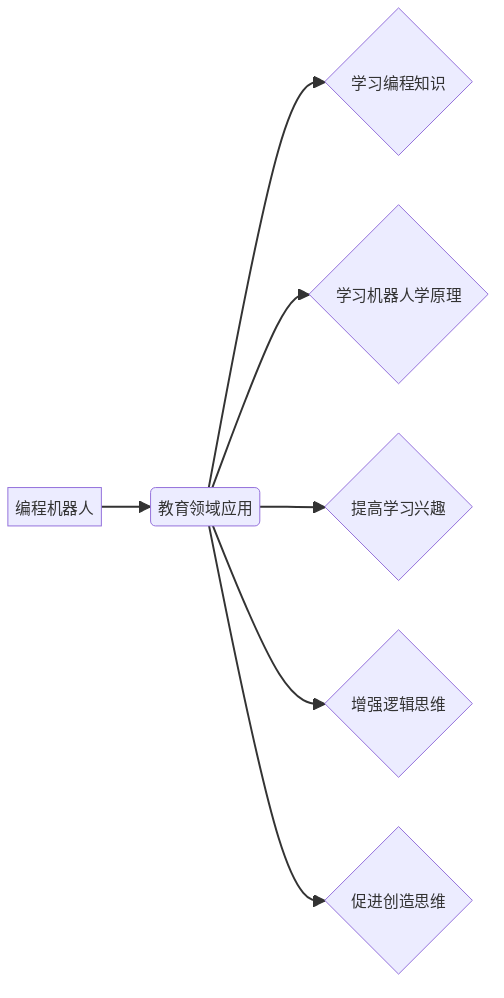
Abstract:
This paper discusses the combination of programming and robotics, and focuses on the principle and application of programming robot. It first discusses the development process and significance of programming robot, and then expounds the application of programming robot in education, medical care and service fields. Then the paper analyzes the technical characteristics of programming robot and puts forward the future development direction of programming robot. By studying the combination of programming and robotics, we explore how to use programming technology to optimize the function and performance of robots. We analyze the application prospect of programming robot in industrial automation, education and training and daily life, and present some solutions and suggestions. Combining practical cases and data, we explore the potential of programming robots to improve work efficiency, cost saving and improve quality of life. This paper summarizes the challenges and opportunities existing in the field of programming robot, and looks forward to the direction and trend of the future development. Through the research of this paper, we can better understand programming robots and provide a reference for further promoting the integration of programming and robotics.
Keywords: programming robotics, robotics, artificial intelligence, automation technology, educational application, industrial application, human-computer interaction design, motion planning and control
1 Introduce
1.1 Foreword
With the rapid development of artificial intelligence and automation technology, programming robot, as a new technology combining programming and robotics, has gradually attracted people's attention. Programming robots can not only help children and teenagers learn programming knowledge, but also play an important role in the industrial production and service industries.
In the modern society, mastering the programming skills has become a basic ability. As an educational tool, programming robots can not only help children develop logical thinking ability and hands-on ability, but also let them learn in play, so as to understand programming knowledge faster and better.
At the same time, programming robots also have a wide application prospect in the industrial production and service industries [1]. For example, some programming robots can help factories automate production and improve productivity and product quality; In the service industry, programming robots can also play tour guides, waiters and other roles to provide more efficient and convenient services.
2 Literature Review
2.1 Programming and robotics concepts

Figure 1: Application of programming robots in the education field
As a product of combining programming and robotics, programming robot is gradually showing great potential in the field of education [2]. Through the programming operation of programming robots, students can learn programming knowledge and robotics principles in practice, and stimulate their interest in science and technology [3]. Programming robots can also help teachers to better guide students to learn, and promote students' hands-on ability and creative thinking. Research shows that the use of programming robot teaching not only improves students' interest and participation in learning, but also enhances their logical thinking and problem-solving ability. Therefore, the introduction of programming robots into the classroom teaching environment is expected to bring a revolution to the field of education, break the shackles of the traditional teaching mode, and stimulate students' passion and creativity in learning.
2.2 Research on robot programming technology
A programmed robot is the use of programming techniques to control the process of a robot performing specific tasks. The study of robot programming technology involves how to design effective programming algorithms and control strategies to realize the autonomous operation and intelligent decision-making of robots in different environments.
In the study of robot programming technology, an important indicator is the efficiency of robots in performing tasks. We can evaluate the efficiency of the robot by the following formula:

Among them, Tasks completed represents the number of tasks completed by the robot, and Time taken represents the time taken to complete these tasks. By calculating the efficiency of the robot's task execution, we can further optimize programming algorithms and control strategies, improving the robot's work efficiency and performance.
2.3 The application status of programming robots
The application of programming robots in various fields is constantly expanding. In the industrial field, programming robots can be used to automate production lines to improve production efficiency and quality. In the field of education, programming robots are used to teach students about programming and to develop their logical thinking and problem solving skills [4]. In the healthcare field, programmed robots can be used for surgical assistance and rehabilitation therapy to improve surgical accuracy and patient rehabilitation effects.
For example, in the field of education, small programming robots are widely used in school programming education, allowing students to learn programming language and logical thinking by manipulating robots, and stimulate their interest in technology and creativity [5]. At the same time, programming robots are also designed as programmable modular systems that can adapt to students of different ages and levels, making teaching more flexible and diverse.
In health care, programmed robots are also used for surgical assistance. Through precise programming and control, the robot can assist doctors in completing the fine operation during surgery, reducing the surgical risk and improving the success rate of surgery. Programmed robots can also play a role in rehabilitation therapy, helping patients to restore muscle function and exercise capacity.
In general, the application of programming robots in industry, education and healthcare is promising, and it will bring more scientific and technological innovation and social welfare to the human society.
3 Key technology for programming robots
3.1 Robot programming language
|
robot programming language |
merit |
shortcoming |
application area |
|
Python |
Easy to learn and easy to use |
The execution efficiency is relatively low |
Education, research |
|
C++ |
High execution efficiency |
The learning curve is steep |
Industry, military |
|
ROS |
Powerful robotic operating system |
High complexity |
Service robots, unmanned vehicles |
Table 1:
In the research paper "Programming Robot: Exploring the Combination of Programming and robotics", we explore the importance and application of robot programming language. The robot programming language is a special programming language designed to enable people to write programs to control and guide the behavior of robots. By understanding how the robot programming language works, we can better understand the development and application of robotics technology. In this paper, we compare different types of robot programming languages and analyze their advantages and disadvantages as well as their application in different fields. It is hoped that these studies can provide some new ideas and inspiration for the future development of robot technology.
3.2 Human-computer interaction design of the programming robot
The design of human-computer interaction of programming robot is very important, which directly affects the efficiency and experience of [6] of users to learn programming and robot operation. When designing the operation interface of the programming robot, it is necessary to consider the different skill levels and usage habits of the user. The simple and clear operation interface can reduce the learning cost of users and enhance users' desire to use.
Among them, human-computer interaction design principles include intuition, consistency, controllability, feedback and fault tolerance. Intuitive means that the user can intuitively understand and use the design of the interface, and complete the task of programming and robot control through intuitive operation; consistency means that the design style and operation mode of each part of the interface are consistent to avoid user confusion and confusion; controllability means that the user can choose and control the interface operation, and realize flexible programming and robot control; feedback means that the interface should timely feedback the user's operation results to enhance the user's operation experience and control sense; Fault tolerance means that the interface should have a certain fault tolerance, can identify and correct the user's error operation, reduce the user's learning costs and operation difficulties.
The human-computer interaction design of programming robots needs to be comprehensively considered and designed according to users 'needs and characteristics, so as to improve users' learning and operation experience, and promote the combination and development of programming and robotics.
3.3 Movement planning and control of the programmed robot
The tion planning and control of programmed robot is one of the key techniques to realize its autonomous intelligent behavior. Path planning is an important link, by determining the best path from the starting point to the target point, avoiding obstacles and optimizing the route. Action design refers to how the robot realizes various actions in the process of movement, such as turning, stopping, acceleration, etc.
In pathway planning, common methods include A * algorithm, Dijkstra algorithm and RRT algorithm. These algorithms can effectively help robots to quickly plan paths in complex environments. The motion design needs to take into account the speed, acceleration, attitude control and other factors of the robot, in order to ensure that the robot can safely and smoothly complete the movement task.
In addition to path planning and motion design, motion control is also an integral part of programmed robots. The control technology enables the robot to achieve accurate and stable movement according to the requirements of path planning and movement design. The PID controller, the model predictive control and other methods are widely used to program the motion control of the robot to realize the precise control of the robot.
4 Case analysis of programming robot application
4.1 Application of programming robots in industrial production
In industrial production, programmed robots are widely used in automated production lines. They are able to receive pre-written instructions and complete various complex operations, such as welding, spraying, handling, etc. The introduction of programming robots by an automobile manufacturing company has significantly improved its production efficiency and product quality. These robots can not only reduce labor costs, but also avoid human error and improve the stability and safety of the production line.
Programmed robots can also be used in the production of medical devices. By setting up different procedures, the robot can complete the precise operation to ensure the quality and accuracy of the product. After the introduction of programming robots by a medical device company, not only the production efficiency has been improved, but also the product quality has been guaranteed, effectively meeting the market demand.
Overall, programmed robots have broad applications in industrial production. Their emergence can not only improve production efficiency and reduce costs, but also improve product quality and enterprise competitiveness. Therefore, exploring the combination of programming and robotics will bring more possibilities and opportunities to industrial production [7].
4.2 Application of programming robots in education and training
The application of programming robots in the field of education and training has become a trend. By manipulating the robot, students can translate abstract programming knowledge into concrete actions, making the learning process more vivid and interesting. Research shows that by interacting with programming robots, it is easier for students to master programming concepts and logical thinking skills, thus improving their programming skills.
Programming robots can also promote students' creativity and teamwork ability. In the programming robot project, students need to work together, work together, and solve problems together, which can exercise students' team spirit and communication and cooperation ability.
Programming robots also play an important role in educational reform. By introducing programming robots into the educational system, students' innovative thinking and problem-solving ability can be cultivated, thus cultivating more creative and capable talents [8] for the future social needs. Therefore, programming robot is not only an educational tool, but also an important means to promote educational reform and change.
4.3 The application of programming robots in medical care
In healthcare, programmed robots are playing an increasingly important role in the world. Surgical robots are one of the areas of concern. They can help doctors perform more accurate and minimally invasive surgical [9] with precisely controlled robotic arms and high-definition cameras. These robots can reduce the risk during surgery, while also improving the success rate of surgery and the speed of patient recovery.
Another application case is the rehabilitation-assisted robot. These robots can help patients with rehabilitation training and improve training efficiency and results. For example, some rehabilitation assistance robots can better help patients recover by monitoring the patient's movements and adjusting the training plan to the situation.
Besides surgery and rehabilitation, there are many other potential applications of programmed robots in healthcare. For example, some robots can be used in drug distribution, patient monitoring, medical records management and other aspects to provide more support and assistance to medical staff.
Overall, programming robots are gradually becoming an important tool in healthcare, providing more possibilities for healthcare workers, while also providing a better treatment and care experience for patients, [10]. As technology continues to evolve and innovate, it is reasonable to believe that the application of programming robots in healthcare will be further expanded and bring more positive effects on human health.
5 Conclusions and outlook
As a new technology combining programming and robotics, programming robot has gradually attracted people's attention. Its application prospect in education and industry is promising. In the field of education, programming robots can help children and teenagers learn programming knowledge and stimulate their interest and creativity. At the same time, it can also improve students' logical thinking and problem-solving ability. In the industrial production and service industries, programming robots can improve production efficiency and product quality, and provide more efficient and convenient services. In the paper, we introduce the basic principles, educational application, industrial applications and future development trends of programming robot. Through an in-depth discussion of the charm of programming robots, we can better understand the combination of programming and robotics, and provide readers with more knowledge and inspiration about programming robots. In general, programming robots have broad application prospects, bringing more scientific and technological innovation and social welfare to human society in different fields.
Funding
This research received no external funding.
Author Contributions
All authors have read and agreed to the published version of the manuscript.
The authors declared that they have no known competing financial interests or personal relationships that could have appeared to influence the work reported in this paper.
References
